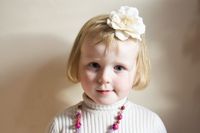MOVIE REVIEW
His & Hers (2009)

The Times BFI 53rd London Film Festival
The movie's gimmick is very simple. Women are filmed in their homes, talking about the men in their lives. But a little more thought has gone into "His & Hers;" the movie begins with a diapered infant being laid down on a layette, and ends with the shot of an elderly woman sitting alone in a home. In between the women featured go up incrementally in age from the first child interviewed — aged about seven — to elderly women who still live on their own.
The discussions about their sons, fathers and husbands living and dead are very ordinary. They talk about what they like, what they do together, things they've said. The teenagers discuss their boyfriends; the pregnant woman talks about her hopes for her soon-to-be-born son; the widows discuss how they miss their husbands and how their sons look after them.
None of the women are on screen for more than about three minutes, and they are all filmed in a similar style: They are in their house, and a detail of their home is picked out, such as the dolls which crowd one woman's mantelpiece, the doilies in another, or the staircase railings. Several women are filmed from the hallway, speaking in voiceover, with the shot encompassing two rooms via the open doors so we can see one woman applying makeup in the room on the left with the door to her bedroom open on the right. Attention is paid to the paint on the walls and the details of the homes; in one marvelous shot, a woman wearing a shirt sold on the High Street plays piano with her back to the camera, and the color of her top matches exactly the brown of her piano and the paint on her wall.
Ken Wardrop's film, which has won awards in Ireland, is an exploration of how a certain section of Irish women relate to the men in their lives. All the women are white, straight and visibly middle-class; only one is a farmer's wife. All of the houses are clean and tidied within an inch of their lives. There's a high level of everyday comfort and success visible, but as the women grow older the houses grow more traditional, with older settees and ovens. The movie feels very comfortable, but not predictable and not safe; the anticipation and excitement of the younger women slowly changes into the sadness, loneliness and contained grief of the older ones. But there's still plenty of hope, such as the young woman who insists she is a good driver, despite her multiple accidents; the older woman who carries the handbag she likes, no matter how ridiculous her children find it; and the elderly woman who sees her little dog as absolutely useless.
Filmed in Athlone and Tullamore, small towns in the Irish Midlands, the recurring imagery of doors, mirrors, cups of tea, little grumbles about other people's habits, makes it very much like everyday life. At the same time, it's a snapshot across the spectrum of a whole society. It ends on a note of despair, but at the same time the whole film has been so uplifting it's impossible not to enjoy it. There's never been another film that feels like visiting a distant but friendly relative; sometimes awkward, sometimes surprising — but no matter what happened, you feel like you're very welcome.
Comments